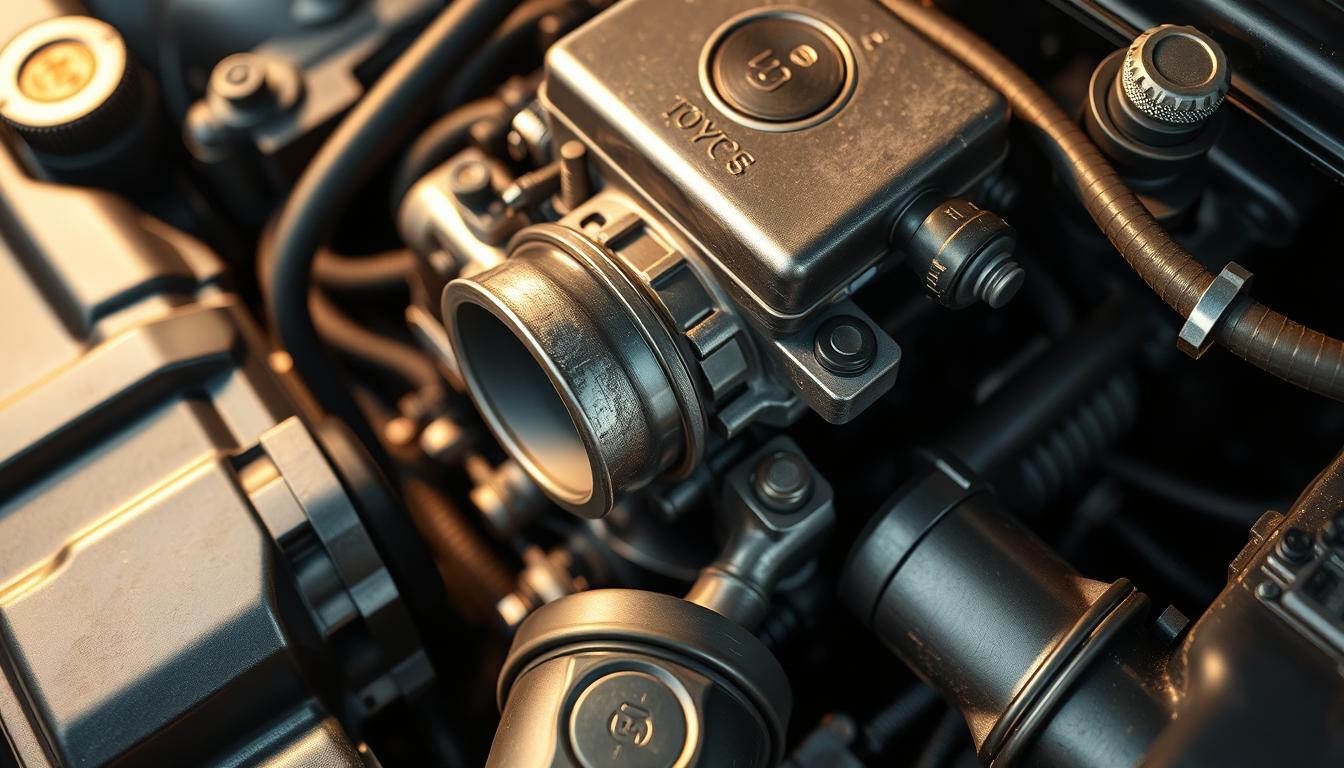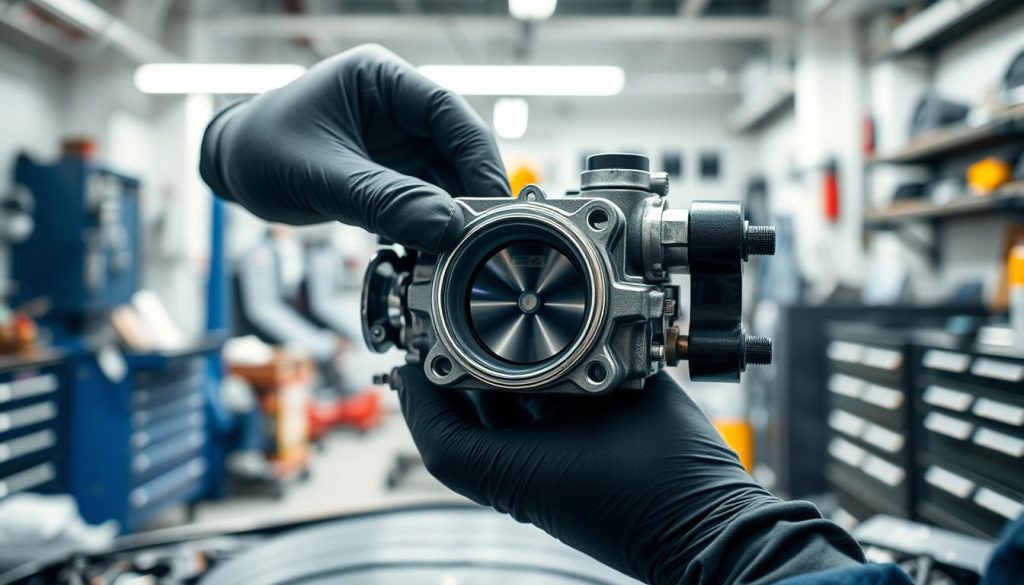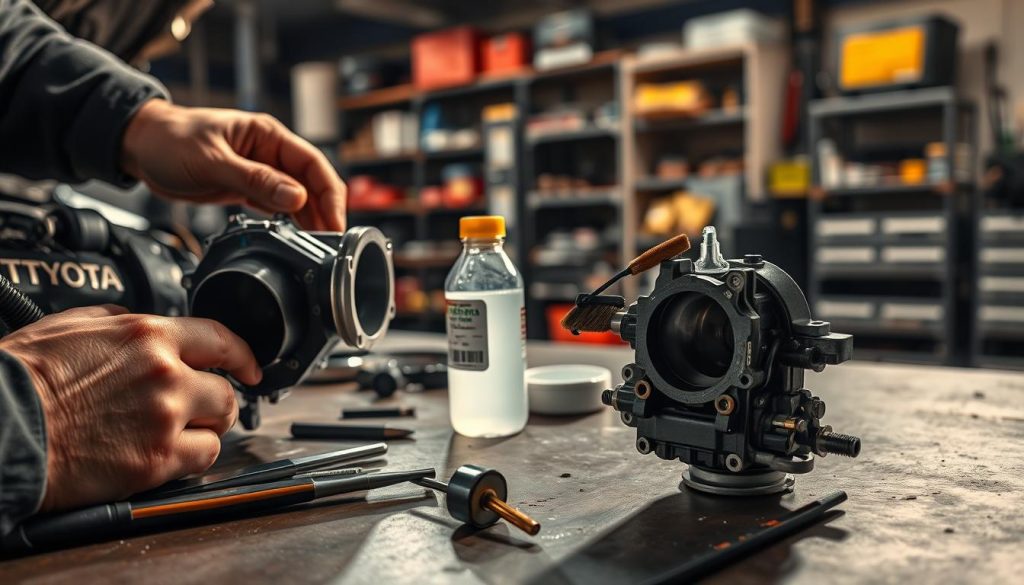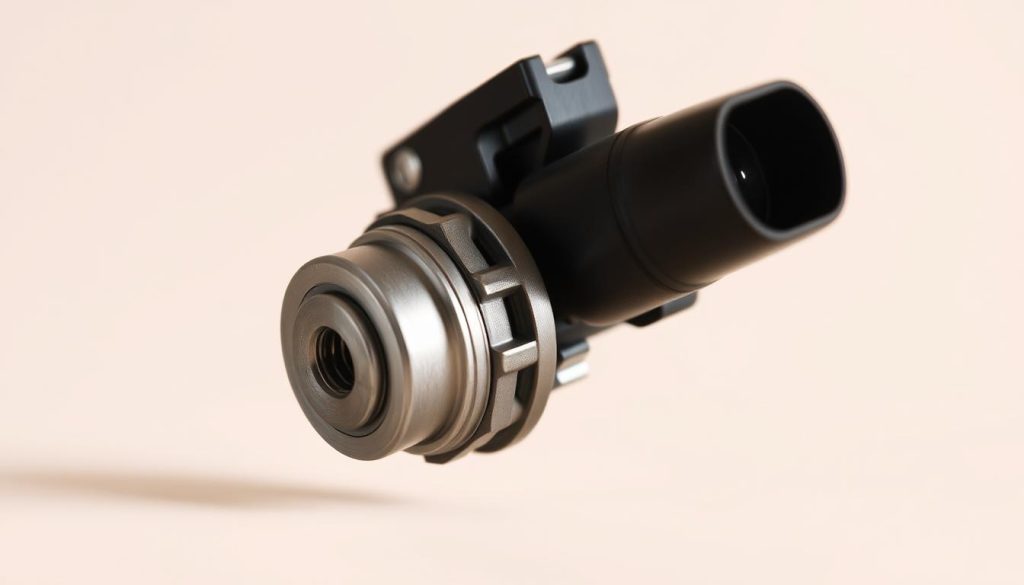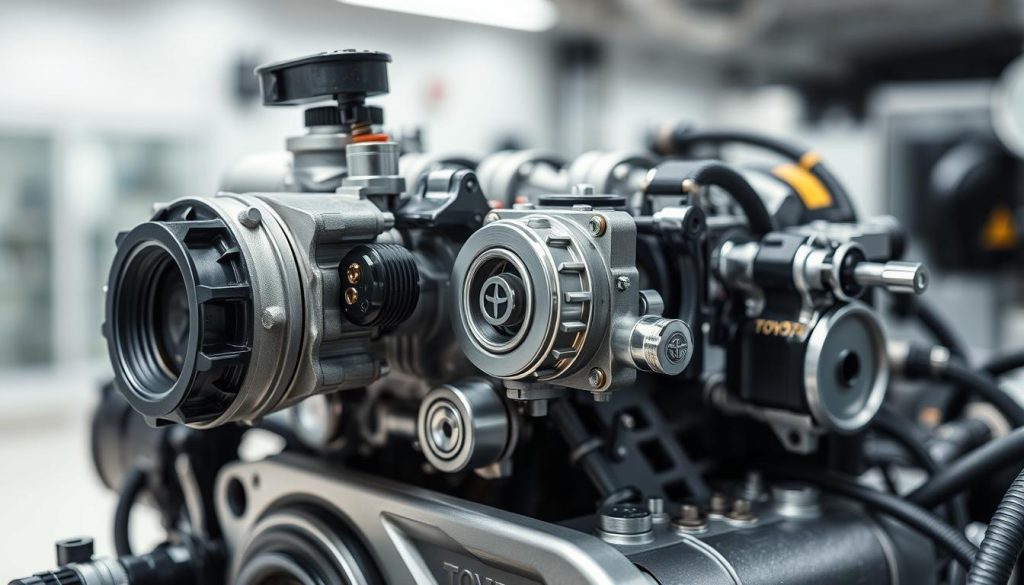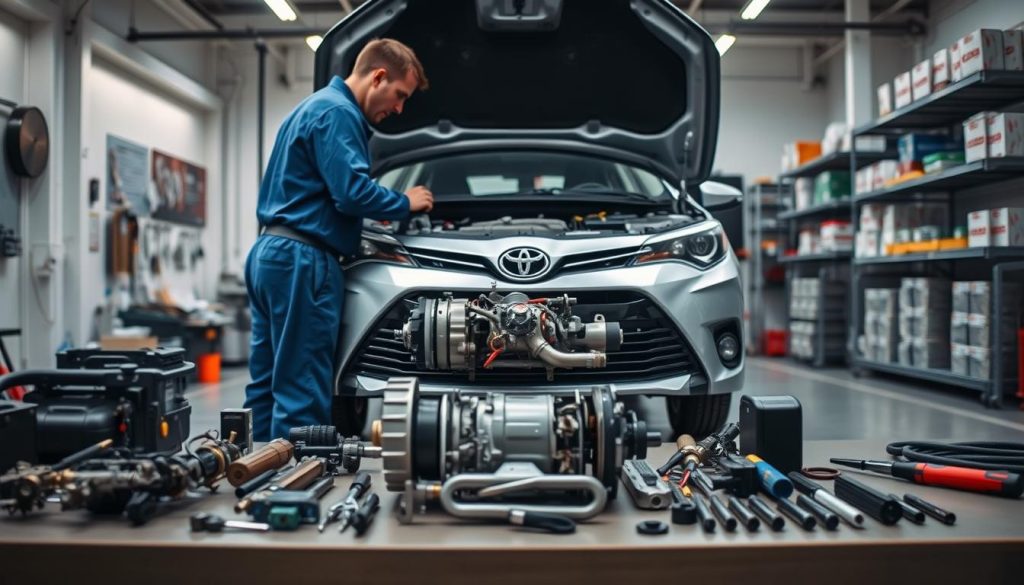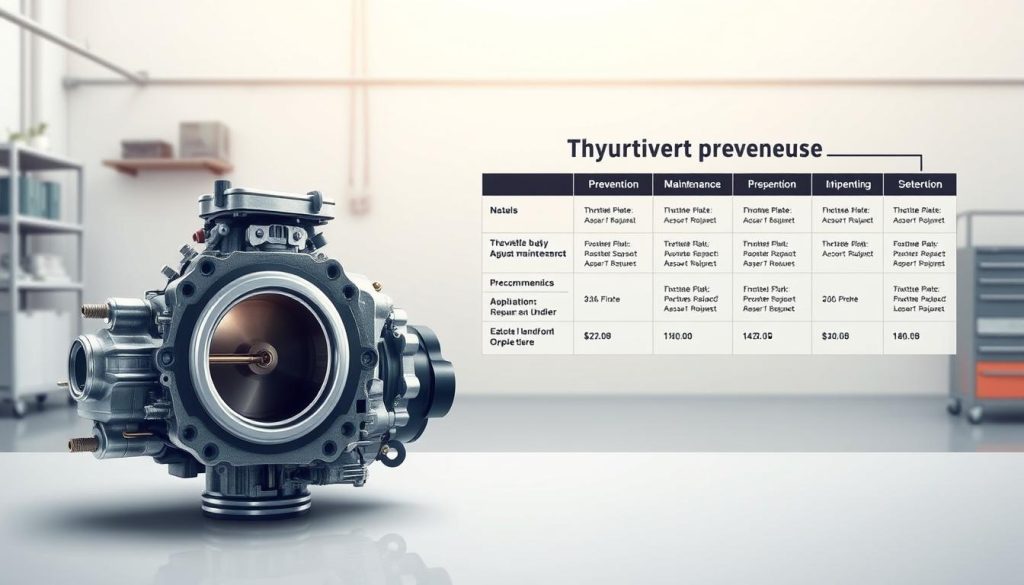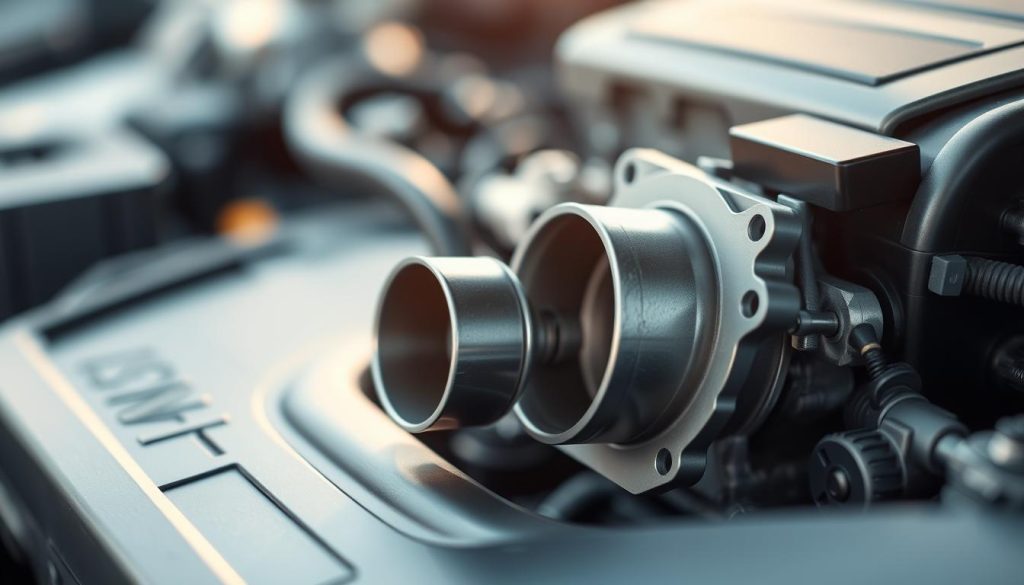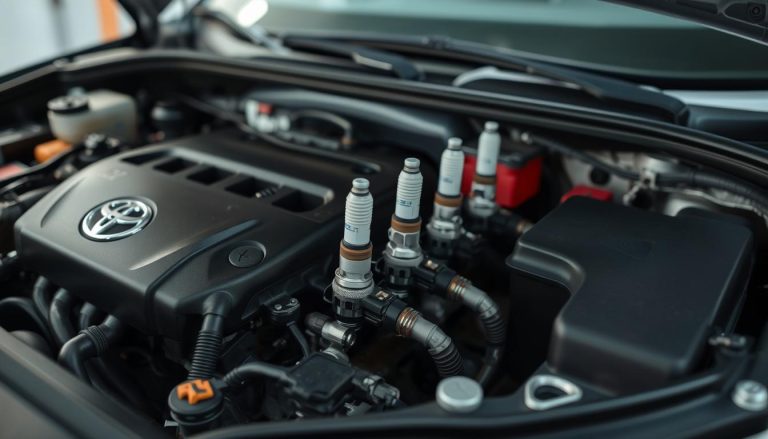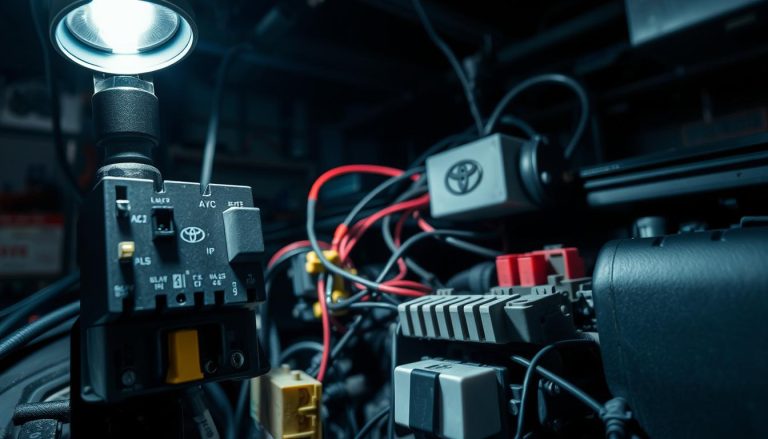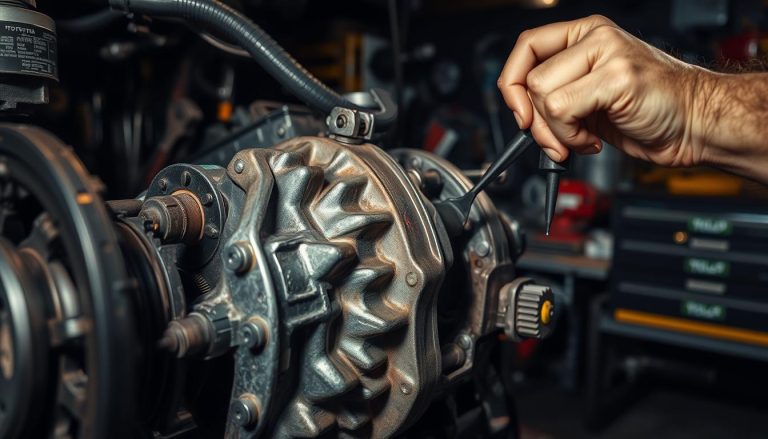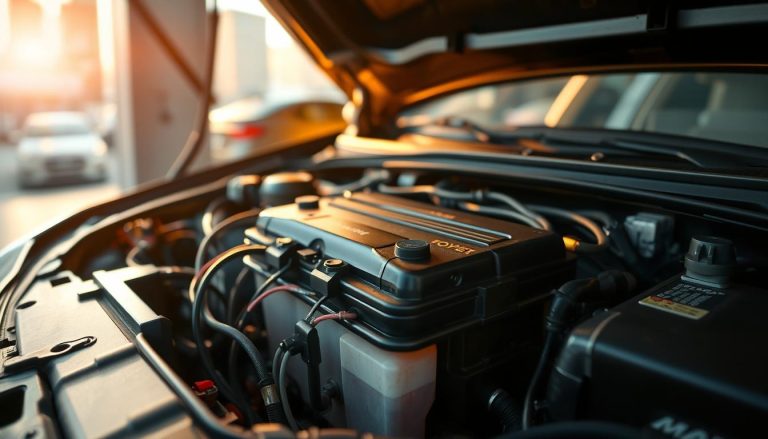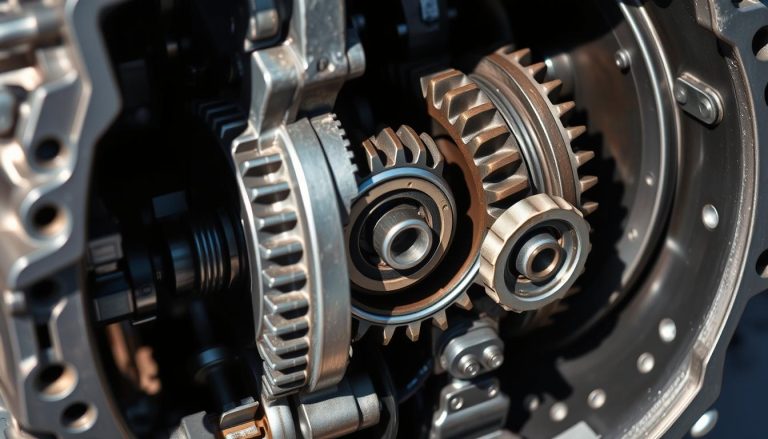Toyota Throttle Body Problems: Causes and Fixes
Your Toyota’s engine needs the right mix of air and fuel to run smoothly. The air intake system plays a key role in this process. At its heart sits a small but mighty component that controls airflow into your engine.
This vital part regulates how much air enters your engine for combustion. When it works properly, your car runs like a dream. But when throttle body issues develop, you’ll notice problems fast.
Dirty or clogged components block proper airflow. This creates a chain reaction of performance issues. Your engine struggles to get the air it needs, leading to poor acceleration and rough idling.
These Toyota engine problems don’t just affect how your car feels to drive. They also waste fuel and can trigger warning lights on your dashboard. Addressing these concerns early saves you money and keeps your vehicle running reliably for years to come.
Key Takeaways
- Air intake components control the precise amount of air flowing into your engine
- Dirty or malfunctioning parts cause poor acceleration and rough idling
- Common symptoms include decreased fuel economy and check engine lights
- Early detection prevents more expensive repairs down the road
- Regular maintenance keeps your Toyota running smoothly and efficiently
- Professional diagnosis helps identify the root cause of performance issues
Understanding Your Toyota’s Throttle Body System
Your Toyota’s throttle body controls airflow into the engine’s combustion chambers. It works with the fuel system to create the right air-fuel mix for best engine performance. Knowing about your Toyota air intake system helps spot problems early, avoiding expensive fixes.
The throttle body is between the air filter and intake manifold. It has a butterfly valve called the throttle plate. This valve opens and closes with your accelerator pedal, controlling air flow into the engine.
What is a Throttle Body and Its Function
The throttle body function is about controlling air for your engine. It’s like a smart gate that opens more when you press the gas pedal. The throttle plate inside moves to let more or less air through.
This part affects your engine’s power. More air means more fuel, making the engine stronger. Less air means less power and better fuel use.
How the Throttle Body Works in Toyota Vehicles
Toyota cars use sensors to watch the throttle plate all the time. The throttle position sensor tells the engine control unit how to adjust fuel. This makes the air-fuel mix just right for smooth running.
Electronic vs. Cable-Operated Throttle Systems
Older Toyotas have cable-operated systems with a direct link between the gas pedal and throttle body. Newer Toyotas use electronic throttle control, or drive-by-wire technology.
Electronic throttle control gets rid of the cable. Sensors track pedal position and send signals to the throttle body. This system improves fuel economy and makes acceleration smoother.
Recognizing Symptoms of Throttle Body Malfunctions
When your Toyota’s throttle body starts failing, you’ll notice several warning signs. These throttle body symptoms often show up slowly. Spotting them early is key to avoiding big problems.
Your car’s computer keeps an eye on the throttle body. If it finds any issues, it acts to protect the engine. Catching these signs early can save you from big troubles.
Engine Performance and Power Issues
One of the first signs is when you press the gas pedal. Your Toyota might feel slow or not respond well. This is because the throttle body can’t control airflow right.
Reduced power output is clear on hills or when speeding up. The engine might not reach high RPMs or feel hesitant. Some say it feels like the engine is “choking” for air.
Idle Problems and Stalling
Toyota idle problems often mean the throttle body is not working right. Your engine might idle roughly or have weird vibrations. The RPM might be off too.
Stalling often happens when stopping completely. This is because the throttle body can’t handle low engine speeds. You might stall at lights, stop signs, or when shifting into park.
Dashboard Warning Lights and Error Messages
Modern Toyotas have smart systems to spot throttle body issues. The check engine light throttle usually comes on when there’s a problem with the throttle or airflow.
You might also see lights for electronic throttle control or stability control. These lights mean your Toyota’s safety systems have found issues. They might cut engine power to keep you safe.
Toyota Throttle Body Problems: Most Common Issues
Toyota drivers often face throttle body issues. These can range from simple contamination to complex electronic failures. These problems can affect your car’s performance and fuel efficiency. Knowing these common issues helps you spot symptoms early and act fast.
Most throttle body malfunctions fall into four main categories. Each type needs different diagnostic and repair methods. Knowing which category your problem is in helps with troubleshooting.
Carbon Buildup and Contamination
Carbon buildup throttle body problems are common. Fuel vapors, oil residue, and environmental contaminants create sticky deposits. These deposits build up on the throttle plate and walls over time.
This buildup disrupts airflow into the engine. Your Toyota may have rough idling, reduced power, and poor acceleration. Coking, as mechanics call it, worsens with high mileage or poor maintenance.
Carbon deposits also make the throttle plate stick or bind. This leads to jerky acceleration and inconsistent idle speeds, frustrating drivers.
Throttle Position Sensor Failures
TPS sensor failure causes serious problems in Toyota vehicles. The throttle position sensor tells the engine computer how far you’ve pressed the pedal. When it fails, the engine gets wrong information about throttle position.
Symptoms include sudden acceleration, engine stalling, and transmission shifting issues. Your throttle position sensor Toyota can fail due to electrical problems or carbon contamination.
Some TPS failures happen gradually, while others occur suddenly. Dashboard warning lights often show up with these sensor problems.
Electronic Throttle Control Malfunctions
Modern Toyotas use drive-by-wire technology instead of traditional throttle cables. Electronic throttle control systems rely on sensors and actuators working together. Communication errors between these components cause performance issues.
The accelerator pedal position sensor may send conflicting signals to the throttle actuator motor. This leads to delayed throttle response or unexpected engine behavior. Limp mode activation often results from these electronic malfunctions.
Mechanical Wear and Physical Damage
Physical damage to throttle body components causes lasting problems. Throttle plate binding occurs when the shaft or bushings wear out. The actuator motor can also fail mechanically, preventing proper throttle plate movement.
Housing damage from improper cleaning or maintenance makes these issues worse. Scratched bore surfaces or damaged gasket sealing areas often require a complete throttle body replacement.
Essential Tools and Equipment for Throttle Body Repair
Having the right tools can make a big difference in your repair experience. Working on your Toyota’s throttle body needs specific tools for safety and efficiency. Make sure you have everything ready before starting to avoid delays and get professional-quality results.
Basic Hand Tools
You’ll need a socket set with both metric and standard sizes. Toyota throttle bodies often use 10mm and 8mm bolts. You’ll also need flathead and Phillips screwdrivers for air intake components.
A good set of pliers is useful for stubborn clamps and electrical connections. Needle-nose pliers are best for tight spaces around the throttle body. Don’t forget a flashlight or headlamp for the dark engine bay.
Electronic Testing Equipment
An OBD scanner Toyota device is key for reading error codes and monitoring data. Basic code readers are good for simple checks. But, advanced scanners offer real-time throttle position readings and system resets.
A digital multimeter is vital for testing electrical connections and sensor voltages. It’s essential for diagnosing throttle position sensor issues or checking wiring.
Cleaning Materials and Protection
Throttle body cleaner spray made for cars is best for removing carbon deposits. Brands like CRC Throttle Body & Air Intake Cleaner and Berryman B-12 Chemtool work well. Avoid brake or carburetor cleaners as they can harm sensitive parts.
Wear chemical-resistant gloves and safety glasses for protection. Throttle body cleaning tools like soft-bristled brushes and clean rags are also needed. Always clean in a well-ventilated area.
| Tool Category | Essential Items | Estimated Cost | Usage Frequency |
|---|---|---|---|
| Hand Tools | Socket set, screwdrivers, pliers | $30-60 | Every repair |
| Diagnostic | OBD scanner, multimeter | $50-150 | Troubleshooting |
| Cleaning | Throttle body cleaner, brushes | $15-25 | Maintenance |
| Safety | Gloves, glasses, ventilation | $10-20 | Every use |
Step-by-Step Throttle Body Inspection Guide
A thorough throttle body inspection is key to saving money on repairs. This guide will help you check your Toyota’s throttle body. It’s a step-by-step guide to spotting problems early and avoiding costly engine issues.
First, make sure your Toyota’s engine is cool. Then, get your tools ready and find a good spot near the engine. This will help you reach all parts easily.
Performing Visual Inspection
Begin by finding the air intake system. Follow the air tube from the air filter to the throttle body. This part is between the air filter and intake manifold.
Remove the air intake tube to see the throttle body. Look for black, sticky carbon buildup. A clean throttle body has little discoloration, but a dirty one has thick, crusty deposits.
Next, check for damage like cracks or corrosion on the throttle body. Throttle body diagnosis often finds these issues by looking at all surfaces and connections.
Testing Throttle Plate Movement and Response
Do a Toyota throttle plate test by pressing the throttle plate with your finger. It should move smoothly without sticking. If it’s electronic, it might not move easily, which is okay.
For cable systems, have someone press the pedal while you watch the plate. It should move right away and smoothly. If it’s slow or jerky, there’s a problem.
A good throttle plate moves smoothly and without hesitation.
Finish the Toyota throttle plate test by checking the return spring. The plate should snap back to closed right away when you let go.
Checking Electrical Connections and Wiring
Look at all electrical connectors for corrosion or moisture. Green or white corrosion means water damage that can cause problems.
Also, check the wiring for damage or pinched wires. These issues can cause the throttle to act strangely and trigger warning lights.
Documenting Your Findings
Keep a detailed record of your throttle body inspection using this table:
| Inspection Area | Condition Found | Action Required | Priority Level |
|---|---|---|---|
| Carbon Buildup | Light/Moderate/Heavy | Clean/Replace | Low/Medium/High |
| Throttle Plate Movement | Smooth/Binding/Stuck | Lubricate/Replace | Medium/High/Critical |
| Electrical Connections | Good/Corroded/Damaged | Clean/Repair/Replace | Low/High/Critical |
| Physical Damage | None/Minor/Severe | Monitor/Repair/Replace | Low/Medium/High |
Take photos of any issues found during your Toyota throttle plate test and throttle body diagnosis. These pictures will help with ordering parts and planning future maintenance.
Diagnostic Testing Using OBD-II Scanner
An OBD-II scanner makes fixing throttle body issues easy. It connects to your Toyota’s computer. It shows fault codes and performance data to help you decide what to do.
Scanners give deep insights into your engine’s throttle system. They spot problems early to avoid big issues. OBD-II throttle diagnosis finds the exact problem.
Common Throttle Body Error Codes
Toyota throttle body error codes show specific problems. The most common codes are about sensor failures or control issues. Knowing these codes helps you fix the problem right.
The P0121 code Toyota means the throttle sensor is off. It turns on the check engine light. Other codes like P0122 and P0123 are for low or high sensor readings.
| Error Code | Description | Common Cause | Repair Priority |
|---|---|---|---|
| P0121 | TPS Range/Performance | Faulty position sensor | High |
| P0122 | TPS Circuit Low Input | Wiring or sensor failure | High |
| P0123 | TPS Circuit High Input | Short circuit or bad sensor | High |
| P2135 | TPS Correlation Error | Multiple sensor mismatch | Critical |
Reading Live Data Streams
Live data shows how your throttle system works in real-time. It helps spot problems before they cause trouble. Look at throttle position percentages during acceleration and braking.
Check for smooth changes from idle to full throttle. Erratic readings mean sensor problems. Airflow should match throttle opening percentages.
Interpreting Test Results
Diagnosing problems means matching scanner data with what you see. Compare freeze frame data to understand when issues happened. This helps you see engine conditions at fault detection.
Many codes often point to one main problem. Pending codes warn of future issues. Document all findings to track problems and check if fixes worked.
How to Clean Your Toyota’s Throttle Body Properly
Learning to clean your Toyota’s throttle body can save you money and boost engine reliability. This throttle body cleaning procedure can also improve power and smooth out engine idling. Many Toyota owners can do this at home with simple tools and patience.
A clean throttle body ensures proper airflow to your engine. Carbon buildup blocks this airflow, leading to performance problems. Regular cleaning can prevent costly repairs later on.
Preparation and Safety Precautions
First, gather all needed tools and materials. You’ll need throttle body cleaner, rags, a toothbrush, and basic tools. Always work in a well-ventilated area when using cleaning chemicals.
Start by disconnecting the negative battery terminal. This step prevents electrical problems during cleaning. Let the engine cool down before starting work.
Wear safety glasses and nitrile gloves when handling solvents. Keep a fire extinguisher nearby, as cleaners are flammable.
Removing the Throttle Body Assembly
Find the air intake tube connected to your throttle body. Remove the clamps and disconnect the tube. Some Toyotas have vacuum lines that need to be disconnected too.
Mark electrical connections with tape before removing them. This makes reassembly easier. Disconnect the throttle position sensor and other electrical connectors.
Remove the throttle body mounting bolts using the correct socket size. Keep these bolts in a safe place as they’re specific to your Toyota model. Lift the throttle body straight up to avoid damaging the gasket.
Cleaning Process and Techniques
The best Toyota throttle body cleaning method combines chemical cleaning and mechanical scrubbing. Spray throttle body cleaner on all carbon deposits inside the housing.
Use a clean toothbrush to scrub stubborn carbon buildup. Move the throttle plate by hand while cleaning to reach all surfaces. Never force the throttle plate as this can damage it.
“A properly cleaned throttle body can improve fuel economy by up to 10% and restore lost horsepower.”
Clean the throttle position sensor with electrical contact cleaner. Wipe all surfaces with lint-free rags until no residue remains. Let everything air dry completely before reassembly.
Reassembly and Initial Testing
Install a new throttle body gasket if the old one is worn. Position the throttle body carefully and tighten mounting bolts to manufacturer specifications. Don’t overtighten as this can crack the housing.
Reconnect all electrical connections and vacuum lines in reverse order. Double-check that everything is properly secured before starting the engine.
Start your Toyota and let it idle for several minutes. The engine may run rough at first as the computer relearns idle settings. Take a short test drive to check for smooth operation and proper throttle response.
Replacing the Throttle Position Sensor
When your Toyota’s throttle position sensor fails, it’s time to replace it. This sensor sends important info to your car’s computer about the throttle valve’s position. It helps your car know if you’re idling, speeding up, or going steady.
A bad TPS can make your car idle rough, hesitate when you press the gas, and use more fuel. Toyota TPS replacement is often cheaper than fixing the whole throttle body. Most Toyota owners can do this fix with basic tools and some patience.
Locating the TPS on Different Toyota Models
The throttle position sensor location Toyota changes with each model and year. On most Camry and Corolla models, it’s right on the throttle body. Look for a small plastic connector with three or four wires on the side of the throttle body.
Toyota trucks like the Tacoma and Tundra have the sensor in different spots because of space. The TPS is usually on the passenger side of the throttle body. SUVs like the RAV4 and Highlander are similar to sedans, with easy access from the top of the engine bay.
Some newer Toyotas put the TPS inside the throttle body assembly. Check your owner’s manual or look up online resources for your model year before starting.
Sensor Removal Process
First, disconnect the negative battery cable to avoid electrical damage. Find the electrical connector on the TPS and press the release tab. Then, pull the connector straight off without twisting or forcing it.
Next, remove the two screws that hold the TPS to the throttle body. These screws are usually Phillips head or Torx bits. Remember the sensor’s orientation before you remove it, as it’s important for accurate readings.
Now, gently pull the old sensor away from the throttle body. Some sensors have a gasket or O-ring that needs to be replaced. Clean the mounting area with a lint-free cloth to ensure the new sensor fits well.
Installing and Connecting the New Sensor
Put the new TPS in the same spot as the old one. The sensor must align with the throttle shaft for accurate readings. Install any new gasket or O-ring that came with the replacement sensor.
Put in the mounting screws and tighten them as the manufacturer suggests, usually 18-25 inch-pounds. Don’t over-tighten, as it can damage the sensor housing or strip the threads in the throttle body.
| Toyota Model | TPS Location | Connector Type | Torque Spec |
|---|---|---|---|
| Camry/Corolla | Side of throttle body | 3-pin connector | 22 in-lbs |
| Tacoma/Tundra | Passenger side TB | 4-pin connector | 25 in-lbs |
| RAV4/Highlander | Top of throttle body | 3-pin connector | 20 in-lbs |
| Prius | Integrated design | 6-pin connector | 18 in-lbs |
Reconnect the electrical connector firmly until you hear or feel it click into place. Make sure the connector is fully seated and the locking tab is engaged properly.
Calibration and Verification Steps
TPS calibration Toyota steps differ for manual and automatic systems. Most modern Toyotas do automatic calibration when you start the engine. Let the engine idle for a few minutes while the ECU learns the new sensor’s baseline readings.
Use your OBD-II scanner to clear any trouble codes related to the throttle position sensor. Start the engine and check live data to confirm the TPS is working right. The sensor should show 0% at idle and increase smoothly as you press the accelerator pedal.
Always use OEM or OEM-equivalent sensors to keep Toyota’s precise calibration standards and ensure long-term reliability.
Take your Toyota for a test drive to check if everything works right. The ECU needs time to relearn throttle position parameters during normal driving. Watch the idle quality, acceleration response, and any warning lights on the dashboard.
Troubleshooting Electronic Throttle Control Systems
Modern Toyota vehicles use Toyota electronic throttle control systems. These systems replace old mechanical cables with new electronic parts. Knowing how they work helps owners fix problems better.
These systems have many sensors and computer parts working together. Dirt on sensors can cause the system to make wrong adjustments. This leads to performance issues that are hard to figure out.
Understanding Drive-by-Wire Technology
Drive-by-wire Toyota systems don’t use a direct mechanical link between the pedal and throttle. Instead, a sensor sends signals to the engine computer. The computer then tells the throttle actuator to adjust the throttle plate precisely.
This tech has many safety features. Redundant sensors watch the system all the time. If one sensor fails, others keep the system safe until it’s fixed.
Common Electronic System Failures
Many parts in these systems can fail. Accelerator pedal sensors might have internal problems or wiring issues. Throttle actuator motors can wear out over time.
Communication problems between modules can cause issues. These problems might not show up as consistent error codes. Updates or technical service bulletins often fix these issues.
Performing System Reset Procedures
Basic throttle control system reset steps can fix minor problems. Turn off the engine and disconnect the battery for ten minutes. This clears fault codes and lets the system start over.
For more complex resets, you need to clear adaptation values from the control module. The system must learn normal operation again after big repairs. Some throttle control system reset steps need special tools to do right.
Complete Throttle Body Assembly Replacement
When cleaning and minor repairs can’t fix your Toyota throttle body, it’s time for a full replacement. This method fixes many problems and makes your engine management system reliable for a long time.
Identifying When Replacement is Necessary
Several signs show when you need a Toyota throttle body replacement. Severe carbon buildup that can’t be cleaned away often damages parts inside.
Physical damage is another reason for replacement. Cracks, warped surfaces, or broken throttle plates mean the system can’t be fixed with simple cleaning or adjustments.
Electronic system failures also mean you need a new throttle body. When the actuator motors in drive-by-wire systems fail, or when many sensors go wrong at once, fixing it might cost more than buying a new one. Failed throttle position sensors and actuator problems usually mean the whole system needs to be replaced.
Selecting the Right Replacement Part
Choosing the right throttle body assembly Toyota part is important. Make sure to check your vehicle’s VIN, engine code, and model year before buying. The part numbers must match exactly for a good fit and function.
OEM parts are guaranteed to fit right and meet Toyota’s quality standards. They might be more expensive but they last longer and work better. Aftermarket parts are cheaper but their quality and reliability can vary a lot.
Think about your vehicle’s age and how you use it when choosing parts. For newer vehicles under warranty, it’s best to use OEM parts. Older, high-mileage Toyotas might do well with quality aftermarket parts.
Installation Process and Considerations
New throttle body installation needs careful steps and the right tools. Start by disconnecting the battery and taking out the air intake assembly. Then, disconnect electrical connectors and vacuum lines, marking where they go back.
Remove the old assembly’s mounting bolts in order and lift it out. If you can, move reusable gaskets and sensors over, but new gaskets are best for a tight seal.
Put the new unit in place using the right torque values. Most Toyotas need 15-20 ft-lbs for the mounting bolts. After it’s in, use a professional scanner to do throttle body adaptation and make sure it’s calibrated right.
Professional Repair vs. DIY Approach
Toyota owners have to decide: fix the throttle body themselves or get a pro to do it. This choice affects your money and your car’s performance. You need to know your skills, how much time you have, and the problem’s details.
Assessing Repair Complexity
For simple fixes, like cleaning the throttle body, DIY is a good option. Most Toyota owners can do this with basic tools and some patience. It involves removing the air intake, spraying cleaner, and cleaning off carbon deposits.
But, if you’re dealing with electronic issues, like throttle position sensors or drive-by-wire systems, it’s more complex. These repairs need advanced knowledge and dealer-level programming, which home mechanics can’t do.
Cost Analysis and Decision Factors
The cost of fixing a Toyota throttle body varies a lot between DIY and professional help. DIY cleaning costs under $20, while professional services cost $150 to $300. Replacing the throttle body can cost over $800 at dealerships.
Think about other costs like tools, possible mistakes, and warranty issues. Professional repairs come with guarantees, but DIY mistakes can lead to more expensive problems.
When to Seek Professional Help
Professional throttle body service is key for complex electronic issues. Get an expert when you see many error codes, need dealer programming, or when safety systems are involved.
Choose pros for warranty-covered cars or if you don’t have the right tools. Toyota specialists have the knowledge and tools to do the job right.
Preventive Maintenance for Throttle Body Longevity
Keeping your throttle body system in good shape saves money and keeps your Toyota running well for years. Prevention costs far less than repair. A good maintenance plan helps avoid unexpected breakdowns. It also keeps your engine running smoothly for the life of your vehicle.
Establishing a Consistent Cleaning Schedule
Your throttle body maintenance schedule should match your driving habits and where you live. Most Toyotas need cleaning every 60,000 to 75,000 miles under normal conditions. But, if you drive in dusty areas or heavy traffic, you might need it every 45,000 miles.
For most drivers, cleaning in spring and fall works well. Spring gets rid of winter dirt, and fall prepares for winter. Adding throttle body service to regular tune-ups ensures you don’t forget this important step.
Air Filter Maintenance Impact
Replacing your Toyota’s air filter is key to keeping your throttle body clean. A dirty air filter lets dirty air in, causing more buildup and less performance. Clean air filters stop 80% of throttle body dirt when changed as recommended.
Most Toyotas need new air filters every 15,000 to 30,000 miles. While premium filters cost more, they filter better and mean less cleaning for your throttle body.
Fuel Quality and System Cleaning
Using high-quality gasoline helps your throttle body stay clean. Top-tier fuel brands have detergents that prevent buildup. But, fuel with more than 10% ethanol can lead to more deposits, needing more maintenance.
Fuel system cleaning is a great match for throttle body maintenance. Every 30,000 miles, a professional service can clean out your system. Using fuel additives monthly can also help keep your system clean and running well.
| Service Type | Frequency | Driving Conditions | Expected Cost |
|---|---|---|---|
| Throttle Body Cleaning | 60,000-75,000 miles | Normal driving | $150-$250 |
| Air Filter Replacement | 15,000-30,000 miles | All conditions | $25-$60 |
| Fuel System Service | 30,000 miles | City/highway mix | $120-$200 |
| Severe Duty Cleaning | 45,000 miles | Dusty/stop-and-go | $175-$300 |
Toyota Model-Specific Throttle Body Considerations
Toyota makes many different cars, and each one has its own throttle body problems. The engine type, how the car is used, and where it’s driven all play a part. Knowing these details helps car owners take better care of their vehicles.
Sedan Performance and Maintenance Needs
The Toyota Camry throttle body wears out differently based on the engine. V6 engines get dirty faster because they need more air. Four-cylinder engines tend to wear more evenly.
Avalon cars are similar to Camry models. They both need careful cleaning of the intake manifold during maintenance. Cleaning every 30,000 miles usually keeps them running well.
Hybrid and Economy Vehicle Challenges
Corolla models have smaller throttle bodies that need gentle cleaning. Toyota Prius throttle problems often come from its special hybrid system. The engine works differently than regular engines.
Hybrid cars don’t use the throttle as much because of the electric motor. But, they can get dirty from electric-only driving. Driving on the highway often helps avoid this.
Heavy-Duty Truck Applications
Toyota Tacoma throttle issues often come from dust when driving off-road. Tundra trucks face similar problems, plus extra stress from towing. Both trucks need air filters changed more often.
Truck throttle bodies handle more air and work harder. Regular maintenance is key to keep them running well under heavy loads.
SUV Balance and Versatility
The Toyota RAV4 throttle body balances efficiency and power. Highlander models have bigger throttle bodies for V6 engines. Both SUVs need to consider how the all-wheel-drive system works.
SUVs face different driving conditions that affect the throttle body. Driving a mix of city and highway helps keep them clean.
| Vehicle Type | Common Issues | Maintenance Interval | Special Considerations |
|---|---|---|---|
| Sedans (Camry/Avalon) | Carbon buildup, TPS failure | 30,000 miles | V6 vs 4-cylinder differences |
| Hybrids (Prius/Corolla Hybrid) | Reduced operation wear | 40,000 miles | Electric motor interaction |
| Trucks (Tacoma/Tundra) | Dust contamination | 25,000 miles | Heavy-duty applications |
| SUVs (RAV4/Highlander) | Variable load conditions | 35,000 miles | AWD system coordination |
Conclusion
Keeping your Toyota throttle body in good shape is key to avoiding expensive engine fixes. By watching for warning signs early, you can save money and avoid headaches later.
Regular cleaning every 30,000 miles helps prevent carbon buildup. Simple checks can spot wear before it gets worse. Your OBD-II scanner is a great tool for finding electronic issues early.
Many tasks, like cleaning and replacing sensors, are easy DIY jobs. But, complex repairs need a pro’s touch.
Proper throttle body care boosts your Toyota’s engine performance. You’ll see better fuel economy, smoother idling, and quicker acceleration. It’s a smart investment in your car’s reliability.
Give your Toyota the care it needs. Start with regular air filter changes and use quality fuel. Don’t wait for emergencies to clean the throttle body.
With this knowledge, you can keep your Toyota running well for years. Know when to DIY and when to ask for help. Your engine will thank you for the care.
FAQ
What are the most common signs that my Toyota’s throttle body needs attention?
Signs include reduced power when accelerating and a rough idle. You might also see the engine stall when stopping. Poor fuel economy and dashboard lights like the check engine light are other signs. Hesitation when accelerating or uneven throttle response are also common.
How often should I clean my Toyota’s throttle body?
Clean it every 30,000 to 50,000 miles under normal driving. If you drive in dusty areas or heavy traffic, clean it every 20,000 to 30,000 miles.
Can I clean my Toyota’s throttle body myself, or do I need professional help?
DIY enthusiasts can clean it with the right tools and supplies. But, if your Toyota has an electronic system, you might need a pro. They can reset and program it correctly.
What’s the difference between electronic and cable-operated throttle systems in Toyota vehicles?
Older models have cable-operated systems. They use a cable to connect the pedal to the throttle plate. Newer models have electronic systems. These use sensors and offer precise control but need special tools for troubleshooting.
How much does it cost to replace a Toyota throttle body?
Costs vary by model and system type. OEM parts cost 0 to 0. Labor adds 0 to 0. Total costs can be 0 to
FAQ
What are the most common signs that my Toyota’s throttle body needs attention?
Signs include reduced power when accelerating and a rough idle. You might also see the engine stall when stopping. Poor fuel economy and dashboard lights like the check engine light are other signs. Hesitation when accelerating or uneven throttle response are also common.
How often should I clean my Toyota’s throttle body?
Clean it every 30,000 to 50,000 miles under normal driving. If you drive in dusty areas or heavy traffic, clean it every 20,000 to 30,000 miles.
Can I clean my Toyota’s throttle body myself, or do I need professional help?
DIY enthusiasts can clean it with the right tools and supplies. But, if your Toyota has an electronic system, you might need a pro. They can reset and program it correctly.
What’s the difference between electronic and cable-operated throttle systems in Toyota vehicles?
Older models have cable-operated systems. They use a cable to connect the pedal to the throttle plate. Newer models have electronic systems. These use sensors and offer precise control but need special tools for troubleshooting.
How much does it cost to replace a Toyota throttle body?
Costs vary by model and system type. OEM parts cost $200 to $800. Labor adds $150 to $400. Total costs can be $400 to $1,200, making maintenance cheaper.
What throttle body error codes are most common in Toyota vehicles?
Common codes include P0121, P0122, P0123, P2135, and P0507. These codes help find specific problems.
Why does carbon buildup occur in Toyota throttle bodies?
It happens from fuel vapors, oil, and environmental contaminants. Poor air filters, low-quality fuel, and short trips can cause buildup.
Are there differences in throttle body problems between Toyota Camry, Corolla, and Prius models?
Yes, each model has its own issues. Camry V6s may have more buildup. Corollas have simpler systems. Prius hybrids need special diagnostic procedures.
Can a dirty air filter cause throttle body problems in my Toyota?
Yes, a dirty air filter can cause buildup and damage. Replace it every 12,000 to 15,000 miles to prevent problems.
What tools do I need to perform basic throttle body maintenance on my Toyota?
You’ll need a socket set, screwdrivers, an OBD-II scanner, and throttle body cleaner. Don’t forget safety gear like gloves and eye protection. For complex repairs, you may need multimeters and more specialized tools.
How do I know if my Toyota’s throttle position sensor needs replacement?
Look for erratic idle speeds, poor acceleration, and error codes P0121-P0123. Use an OBD-II scanner to check voltage readings against throttle plate position.
Is it safe to drive my Toyota with throttle body problems?
Minor issues might not be a problem. But, driving with major problems can harm your engine and be dangerous. If you notice severe symptoms, get it checked right away.
Do Toyota trucks and SUVs have different throttle body maintenance requirements?
Yes, trucks and SUVs need more maintenance due to towing and off-road driving. Clean the throttle body and replace air filters every 20,000 to 30,000 miles.
Can fuel additives help prevent Toyota throttle body problems?
Fuel system cleaners and top-tier gasoline can help. But, they’re not a replacement for cleaning. Use them as part of a maintenance plan.
What should I do if my Toyota’s electronic throttle control system fails?
If it fails, it may go into limp mode. Pull over and use an OBD-II scanner to find error codes. Many problems need a pro with dealer-level equipment for repair.
,200, making maintenance cheaper.
What throttle body error codes are most common in Toyota vehicles?
Common codes include P0121, P0122, P0123, P2135, and P0507. These codes help find specific problems.
Why does carbon buildup occur in Toyota throttle bodies?
It happens from fuel vapors, oil, and environmental contaminants. Poor air filters, low-quality fuel, and short trips can cause buildup.
Are there differences in throttle body problems between Toyota Camry, Corolla, and Prius models?
Yes, each model has its own issues. Camry V6s may have more buildup. Corollas have simpler systems. Prius hybrids need special diagnostic procedures.
Can a dirty air filter cause throttle body problems in my Toyota?
Yes, a dirty air filter can cause buildup and damage. Replace it every 12,000 to 15,000 miles to prevent problems.
What tools do I need to perform basic throttle body maintenance on my Toyota?
You’ll need a socket set, screwdrivers, an OBD-II scanner, and throttle body cleaner. Don’t forget safety gear like gloves and eye protection. For complex repairs, you may need multimeters and more specialized tools.
How do I know if my Toyota’s throttle position sensor needs replacement?
Look for erratic idle speeds, poor acceleration, and error codes P0121-P0123. Use an OBD-II scanner to check voltage readings against throttle plate position.
Is it safe to drive my Toyota with throttle body problems?
Minor issues might not be a problem. But, driving with major problems can harm your engine and be dangerous. If you notice severe symptoms, get it checked right away.
Do Toyota trucks and SUVs have different throttle body maintenance requirements?
Yes, trucks and SUVs need more maintenance due to towing and off-road driving. Clean the throttle body and replace air filters every 20,000 to 30,000 miles.
Can fuel additives help prevent Toyota throttle body problems?
Fuel system cleaners and top-tier gasoline can help. But, they’re not a replacement for cleaning. Use them as part of a maintenance plan.
What should I do if my Toyota’s electronic throttle control system fails?
If it fails, it may go into limp mode. Pull over and use an OBD-II scanner to find error codes. Many problems need a pro with dealer-level equipment for repair.

